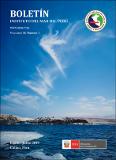Por favor, use este identificador para citar o enlazar este ítem:
https://hdl.handle.net/20.500.12958/3366Registro completo de metadatos
| Campo DC | Valor | Lengua/Idioma |
|---|---|---|
| dc.contributor.author | Sánchez, Sonia | - |
| dc.contributor.author | Villanueva Merino, Patricia | - |
| dc.contributor.editor | Instituto del Mar del Perú | - |
| dc.date.accessioned | 2019-09-11T14:28:50Z | - |
| dc.date.available | 2019-09-11T14:28:50Z | - |
| dc.date.issued | 2019 | - |
| dc.identifier.citation | Bol Inst Mar Perú. 34(1) 2019: p.7-14 | es_ES |
| dc.identifier.issn | 03787702 | - |
| dc.identifier.uri | https://hdl.handle.net/20.500.12958/3366 | - |
| dc.description.abstract | En el área que abarcó de Ilo a Paita se recolectaron 77 muestras utilizando una red de fitoplancton con 75 micras de abertura. Los volúmenes de plancton alcanzaron el valor medio de 0,33 mL/m3, con importantes núcleos dentro de las 60 mn frente a Punta Gobernador y San Juan. El fitoplancton fue escaso al norte y sur del litoral, mejorando su distribución por fuera de las 60 mn en Chicama, Chimbote, Callao y Pisco. Predominaron diatomeas de fases intermedias e iniciales, en la sucesión ecológica, al norte de 12°S y al sur solo lo hicieron especies de fases intermedias. Organismos productores de mareas rojas como Prorocentrum cordatum (Ostenfeld), P. micans Ehrenberg y Akashiwo sanguinea (Hirasaka) fueron registrados indistintamente a lo largo de la costa. El indicador de ACF Protoperidinium obtusum (Karsten) fue localizado principalmente dentro de las 30 mn, excepto en Chicama, Chimbote y Chancay donde llegó a más de 60 mn. Ceratium incisum (Karsten), indicador de Aguas Subtropicales Superficiales (ASS) fue determinado a 120 mn de la costa frente a Punta Falsa. | es_ES |
| dc.description.abstract | ABSTRACT: In the area from Ilo to Paita, a total of 77 samples were collected using a phytoplankton net (75 μm). Plankton volumes reached a mean value of 0.33 mL/m3 and there were important nuclei within 60 nm off Punta Gobernador and San Juan. Phytoplankton was scarce north and south of the coast and its distribution improved outside 60 nm in Chicama, Chimbote, Callao, and Pisco. Intermediate and early-stage diatoms were prevalent in the ecological succession north of 12°S, and only intermediate-stage species were predominant in the south. Red tide organisms such as Prorocentrum cordatum (Ostenfeld), P. micans Ehrenberg, and Akashiwo sanguinea (Hirasaka) were recorded indistinctly along the coast. The CCW indicator Protoperidinium obtusum (Karsten) was mainly located within 30 nm, except in Chicama, Chimbote, and Chancay where it reached more than 60 nm. Ceratium incisum (Karsten), which is an indicator of Subtropical Surface Waters (SSW) was determined at 120 nm off Punta Falsa. | - |
| dc.language.iso | spa | es_ES |
| dc.publisher | Instituto del Mar del Perú | es_ES |
| dc.relation.ispartofseries | Boletín IMARPE;34(1), 2019 | - |
| dc.rights | info:eu-repo/semantics/openAccess | es_ES |
| dc.rights.uri | https://creativecommons.org/licenses/by/4.0/ | es_ES |
| dc.source | Instituto del Mar del Perú - IMARPE | es_ES |
| dc.source.uri | Repositorio Digital IMARPE | es_ES |
| dc.subject | Fitoplancton | es_ES |
| dc.subject | Indicadores biológicos | es_ES |
| dc.title | Productores primarios frente a la costa peruana durante el verano 2005. Cr. Evaluación de pelágicos BIC SNP-2, José Olaya | es_ES |
| dc.title.alternative | Primary producers off the Peruvian coast in summer 2005. Pelagic Resources Cruise RV SNP-2, Jose Olaya | es_ES |
| dc.type | info:eu-repo/semantics/article | es_ES |
| Aparece en las colecciones: | Boletín 34(1), 2019 | |
Ficheros en este ítem:
| Fichero | Descripción | Tamaño | Formato | |
|---|---|---|---|---|
| Boletin 34(1)-1.pdf | 1,01 MB | Adobe PDF |  Visualizar/Abrir |
Este ítem está sujeto a una licencia Creative Commons Licencia Creative Commons

